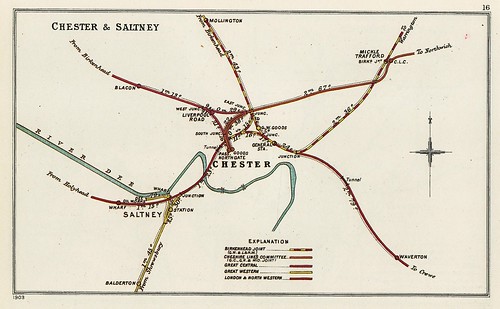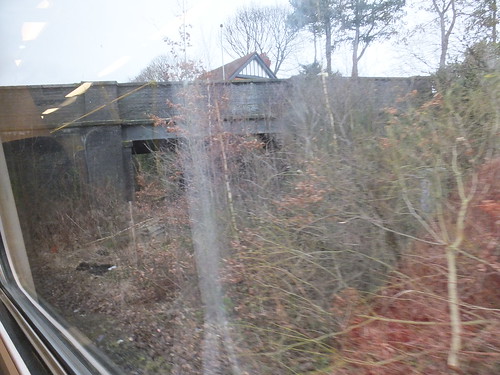Development of the Railways to Birkenhead
Once the Grand Junction Railway had linked the Liverpool and Manchester Railway to the London and Birmingham Railway, Crewe became the obvious starting point for a branch to Chester. The Chester and Crewe Railway Company built the 11-mile branch with Robert Stephenson as the Engineer and Thomas Brassey as the Contractor. Before the line opened in 1840, the Chester and Crewe Railway Company had been absorbed by the Grand Junction Railway. Also in 1840, a separate railway linking Chester and Birkenhead opened, initially as a single line.
The Chester - Birkenhead Route
The Chester and Birkenhead Line eventually became a joint L.M.S./G.W.R. line and traffic growth resulted in most of the route being quadrupled. The junction with the North Wales line was made at Chester No. 4 signal box, just to the west of Chester station. The next signal box, Chester No. 5, was just 300 yards away, controlling the connections which completed a triangular junction with the North Wales line at Chester No. 6. This allowed trains approaching Chester from the west (and, in particular, Great Western trains from Wrexham which had joined at Saltney Junction) to join the Birkenhead Line without a reversal in Chester station. No. 4 and No. 6 boxes were L&NWR designs, as were a number of the signalboxes on the line to Birkenhead.
 Click here for larger image
Click here for larger imageRailway Clearing House Plan of Chester area in 1903
The first four miles beyond Chester No. 5 were double track but from Ledsham Junction four running lines (paired by use) were provided - Down Slow, Up Slow, Down Fast, Up Fast. Today, Merseyrail only uses two lines, generally the former Slow lines, but where roads cross the railway, the bridges over the other two lines remain, with the tracks lifted and overgrown.
 View from an Up Merseyrail train, showing the overgrown trackbed of the former Fast lines.
View from an Up Merseyrail train, showing the overgrown trackbed of the former Fast lines.
On the Birkenhead side of Rock Ferry (which offered interchange with Mersey Railway services), the four-track joint line continued to Green Lane Junction signal box where the Slow Lines became Goods Lines and Fast Lines became Main Lines to Blackpool Street signal box (near the side-by-side locomotive sheds for the L.M.S. and G.W.R.). Beyond Blackpool Street, the Goods Lines entered Haymarket Tunnel, emerging at Brook Street signal box and splitting into two routes serving the dock area. The Main Lines entered Woodside Tunnel at Blackpool Street, emerging at Birkenhead Woodside passenger terminus.
The Mersey Railway
The Mersey Railway opened in 1886, linking Liverpool Central with Birkenhead. Later, it was extended to two separate terminal platforms at Rock Ferry station on the Chester-Birkenhead line. A branch from Hamilton Square made an end-on junction with the Wirral Railway at Birkenhead Park. In 1903, the Mersey Railway was electrified. For a brief description, see Early Days of the Mersey Railway. After the electrification of the Wirral lines in 1938, the L.M.S. introduced through running with the Mersey Railway. In 1977, the 'Liverpool Loop' was opened by British Railways, allowing closure of a number of signal boxes.
The Wirral Railway
The Wirral Railway was incorporated in 1862 as the Hoylake Railway, becoming the Wirral Railway in 1882. At Birkenhead Park it made an end-on connection with the Mersey Railway line from Hamilton Square then continued through Birkenhead North to a triangular junction east of Bidston Station. One branch continued via Bidston Station (where a branch from Wrexham joined) to West Kirby, the second branch served New Brighton, with a second triangular junction connecting a branch to Seacombe which closed in 1964. There's a short Wikipedia article here. At the grouping, the line became part of the L.M.S., continuing to use steam locomotives until electrification at 650v d.c. third rail in 1938. From West Kirby, a single line branch originally continued to Hooton
Signal boxes in the 1950s
The lines were generally controlled by semaphore signals and manual signal boxes with partial track circuiting, although the former Mersey Railway underground lines had colour lights and extensive track circuits.
Chester-Birkenhead line
The signal boxes are listed below:-
Chester No. 5 (81-lever L&NWR Tappet Frame)Former Wirral Railway signal boxes
Mollington (25-lever L&NWR Tappet Frame)
Capenhurst (65-lever Frame)
Ledsham Jn. (20-lever L&NWR Tumbler Frame)
Hooton South Jn. (128-lever L&NWR Tumbler Frame)
Hooton North Jn. (90-lever L&NWR Tumbler Frame)
Bromborough (36-lever L&NWR Tumbler Frame)
Spital (36-lever L&NWR Tumbler Frame)
Port Sunlight Siding (50-lever L&NWR Tumbler Frame)
Bebington & New Ferry (36-lever L&NWR Tumbler Frame)
Rock Ferry
Mersey Jn. (60-lever L.M.S. Frame)
Green Lane Jn. (60-lever L.M.S. pre-1943 Tappet Frame)
Blackpool St. (70-lever L&NWR Tumbler Frame)
Birkenhead Woodside
Birkenhead Park (Cabin 'H': 60-lever LMS tappet)The Mersey Railway
Birkenhead North No. 1: 40-lever R.S.C. 5.5" tappet
Birkenhead North No. 2: 27-lever R.S.C. frame (Goods lines only)
Bidston East Jn.: 45-lever standard tappet.
Seacombe Jn.: 45-lever standard composite
Wallasey
New Brighton: 44-lever R.S.C. tappet
Slopes Branch Jn. (closed 1964)
Seacombe Goods (closed 1964)
Seacombe (closed 1964)
Bidston Dee Jn.: 65-lever 4.5" centres
Leasowe Level Crossing: Pre-1943 standard tappet
Moreton: 30-lever standard frame
Hoylake: 21-lever R.S.Co. 5.5" centres
West Kirby: 63-lever L.M.S. frame
Liverpool Central East ('A' Box): Closed 1977There are detailed diagrams for these signal boxes in the 1950s in the excellent publication from the Signalling Record Society 'British Railways Layout Plans of the 1950's' - 'Volume 10: LNW Lines in North Wales, Chester and Wirral areas' (ISBN: 1-873228-12-0).
Liverpool Central West ('B' Box): Closed 1977
James Street ('C' Box): Closed 1977
Hamilton Square ('D' Box): Closed 1977
Birkenhead Central ('E' Box)
Green Lane ('F' Box)
Book References
[1] 'Railways to the Coast' by Michael H. C. Baker, published by Patrick Stephens (ISBN 1-85260-058-6).
[2] 'An Historical Survey of Selected LMS Stations' by Dr. R. Preston Hendry & R. Powell Hendry: Layouts & Illustrations, published by Oxford Publishing Co. (ISBN 0 86093 168 4).
[3] 'An Historical Survey of Selected LMS Stations: Layouts & Illustrations Volume 2' by Dr. R. Preston Hendry & R. Powell Hendry, published by Oxford Publishing Co. (ISBN 0-86093-330-X).
[4] 'A Pictorial Record of L.M.S. Architecture' by V. R. Anderson and G. K. Fox, published by Oxford Publishing Co. (SBN 86093 083 1).
[5] 'A Regional History of the Railways of Great Britain: Volume 10 The North West by Geoffrey O Holt, published by David & Charles (ISBN 0946537 34 8).
Reference [2] above has more information about Birkenhead North station.
References [3] and [4] above have more information about New Brighton Station.
Related articles on other sites
On Track in North Wirral.
Bidston Dock (Wikipedia).
Birkenhead Dock Branch (Wikipedia).
Mersey Railway (Wikipedia).
The Wirral Railway (Wikipedia).
Wirral Railway ('Railway Magazine' articles).
'Railscot' Chester and Birkenhead.
Related posts in this blog
Early Days of the Mersey Railway.
Birkenhead and New Brighton by train (Part 1)
Birkenhead and New Brighton by train (Part 2)
Birkenhead and New Brighton by train (Part 3)
My pictures
North Wales Line (Crewe - Llandudno).
Merseyrail.
Birkenhead and its Docks.
